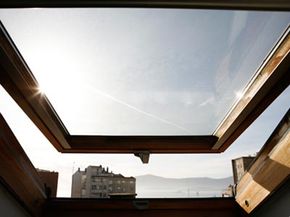Skylight Safety
People typically install skylights in bathrooms and kitchens in their homes. A skylight in the bathroom gives the room more natural sunlight, yet still maintains the privacy of the area. People tend to spend a lot of time in their kitchens, cooking and eating, so bathing this room in natural light is a nice way to spend mornings, afternoons or early evenings.
Whenever it's necessary to work around skylights, people need to pay extra attention to prevent any kind of fall accidents. A skylight accident can result in a long fall, which is bad enough, but there's also the added danger of broken shards of glass or plastic. There are as many as 36 fatal falls through skylights each year and as many as 50 nonfatal falls, the majority of which occur in construction jobs [source: USGlass News Network].
Advertisement
To minimize falls through these roof openings, the American Architectural Manufacturer's Association (AAMA) has provided several suggestions for safety around skylights. For one, anyone going up onto a roof, especially in the instance of construction, should be a professional who is properly trained in roof safety. Most accidents aren't caused by someone simply stepping through a skylight. According to the AAMA, other roof hazards -- such as uncovered openings -- are often to blame.. There should also be proper warning signs on and around the skylights when anyone is up on the roof.
For extra protection, homeowners and office building managers can install a skylight screen or railing over the skylights, which covers any glass or plastic and offers additional protection from accidental falls. They typically come in several different model types and sizes and fasten to or clamp down over the skylight. Most screens are dome-shaped and meant to fit over bubble-shaped plastic skylights, but some are flat and won't allow room for a skylight to open (if, of course, it's designed to open in the first place). Railings on the other hand, are much more prominent but are an obvious obstruction for anyone walking around on the roof.
For more illuminating information on skylights and related topics, take a look at the links below.
Related HowStuffWorks Articles
More Great Links
Sources
- American Architectural Manufacturer's Association."AAMA's Skylight Council publishes Fall Protection paper." (Dec. 8, 2008) http://www.usgnn.com/documents/newsFall20081215.pdf
- American Architectural Manufacturer's Association."Glossary of terms." (Dec. 8, 2008) http://aamanet.org/general.asp?sect=1&id=241
- Kraft, Ulrich. "Lighten up." Scientific American. Sept. 21, 2005. (Dec. 8, 2008) http://www.sciam.com/article.cfm?id=lighten-up
- U.S. Department of Energy. "Skylight glazing." A Consumer's Guide to Energy Efficiency and Renewable Energy. (Dec. 8, 2008) http://apps1.eere.energy.gov/consumer/your_home/windows_doors_skylights/ index.cfm/mytopic=13670
- USGlass News Network. "Should an impact resistance standard cover all skylights?" (Dec. 8, 2008) http://www.usgnn.com/newsSkylight20080430.htm
